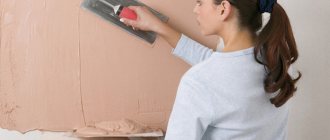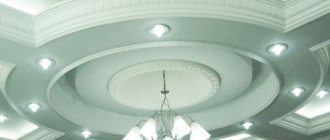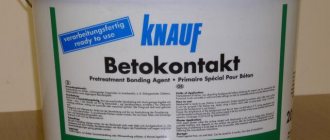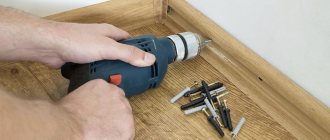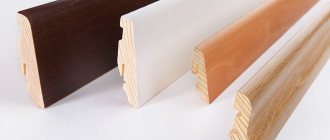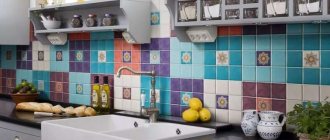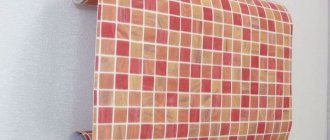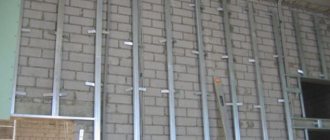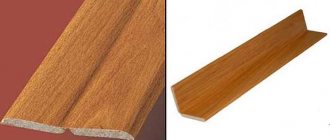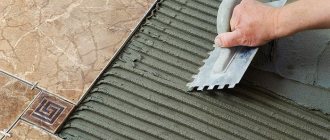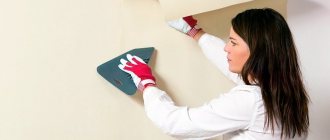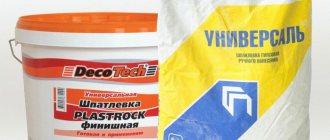Any plinth gives the flooring a finished, neat look, so installing it at the final stage of renovation is indispensable. Today, products made from different materials are widely available on sale - plastic, natural wood and MDF. Skirting boards made of MDF, just like those made of any other materials, can have different profiles in cross-section, dimensions, structure, and depending on this, the method of attaching them to the wall is selected. In particular, installation of MDF plinths can also be done in several ways.
Installing a plinth made of MDF, plastic, or wood with your own hands is not a difficult task at first glance. But if you don’t know all the nuances, how to fasten, how to join, how to design corners, etc., then this work can waste a lot of your time, effort and nerves.
First, it’s worth talking about the functionality of the plinth as an element of the interior.
Functionality of MDF plinth in the interior
This seemingly inconspicuous detail in the interior is quite important for its overall design. It is difficult to imagine the respectability of a room in which there is no baseboard framing of the floor covering. However, this element performs not only decorative functions, since previously it had a different purpose.
Initially, when arranging wooden floors, the baseboard was primarily intended for a kind of insulation. The fact is that there is always a gap left between the boards and the wall, which serves for thermal expansion of the wood. But such a remaining gap often became the reason for the unhindered flow of cold air from the underground. It was to avoid this that they began to fasten skirting boards along the walls.
Currently, this function of the plinth has practically lost its relevance. With the advent of modern construction technologies and materials, the problem of loose fit in the area of joints has practically exhausted itself. For example, laying MDF skirting boards does not serve the purpose of protecting against drafts or hiding flaws when installing the floor covering. The joints of MDF skirting boards fit very tightly to the wall and floor covering, so the installation of the floor covering must be done with the highest possible quality.
In modern apartments and private houses with concrete and other floors, the plinth serves to protect the edge of the flooring - laminate, linoleum or carpet, from damage and penetration under it, as well as into the gap between the flooring and the wall, dust, dirt and moisture. Installing MDF skirting boards is an excellent option for protection against contamination. In the manufacture of MDF skirting boards, a technology is used that turns the skirting board into a “repellent” of dirt. This means that dust and dirt do not eat into the surface of the baseboard, which is especially important, since white MDF baseboards are especially popular in the interior at present.
The presence of cable channels in the back wall of the plinth allows you to hide communications, for example, television cable, telephone or for connecting to the Internet. The design of the MDF plinth provides for the presence of grooves and cable channels for placing wires. The small thickness of the MDF plinth is not an obstacle to placing even several cable channels between the plinth and the wall.
Modern products have a very aesthetic appearance, which allows the plinth to be used as a special decorative element of interior design. MDF plinths have excellent aesthetic characteristics, can be used in interiors of any style, and have a wide range of colors and models.
Functional Features
Gradually, the opinion developed that the plinth has a decorative purpose. It’s hard to imagine decorating the premises without it.
However, everything is not as simple as it seems.
This cladding element arose as additional insulation for wooden buildings at the joints of perpendicular surfaces. A gap is left between the base and the plank sheathing for expansion of the wood structure under the influence of temperature or moisture.
At the same time, cold penetrated through the left space into the house, which was completely eliminated after installing the baseboards.
Today this is a way to protect the edges of decorative materials and flooring from moisture, scuffing, and contamination. Products are available with a cable channel or a special angle of inclination, which allows the wires to be laid using an invisible method.
Most of the products have a beautiful appearance that complements the interior.
MDF skirting boards - what is it?
Everyone is familiar with MDF boards, used as a facing material and widely used in furniture production. They are produced in a wide range of thicknesses and shapes, most often decorated with a special polymer film with a pattern, usually imitating various wood textures. MDF skirting boards are their closest “relatives”. What are MDF skirting boards?
No matter how hard they try to freely decipher this abbreviation! Some argue that this is a designation for “fine fraction” or “modified fiberboard.” Interestingly, both options are quite close to the truth. Indeed, MDF is a step forward compared to the usual fiberboard. And in the production of this material, wood fibers are ground to very small sizes. But still, in fact, this is the Russified English abbreviation MDF: “Medium Density Fiberboard”, literally translated - “medium density fiberboard”.
MDF skirting boards are made from crushed wood fibers, which, when heated and pressed, release natural glue - lignin, which is an excellent binder for the created mass. Manufacturers position MDF as an environmentally friendly material, but in fact, to bind fibers, some companies sometimes use formaldehyde resins, which are not at all beneficial to human health. This factor must be taken into account when choosing this material for finishing - it is better to give preference to manufacturers with a consistently high reputation.
MDF skirting boards are made from boards that are not yet decorated with film. The blanks are cut and processed on special milling equipment, where they are given the intended shape and relief pattern. After this, the skirting boards are cleaned of dust, and their front surface is laminated with a self-adhesive polymer film.
Taking into account the manufacturing technology, MDF skirting boards most often have the form of a profiled smooth board, which is sometimes also decorated with simple reliefs, milling, without any special frills. Variants are produced with an insert-bar along the entire length of the plinth. This detail allows you to simplify installation as much as possible - it will perfectly hide all the heads of the fasteners after installing the plinth on the wall. In addition to lamination, natural veneer and painting are used to decorate the front side of MDF skirting boards.
Veneered plinths, instead of PVC film, are covered with veneer made from natural wood of expensive species. Therefore, in appearance they are almost impossible to distinguish from real wooden ones. Skirting boards can also be sold in painted form. For such decoration, special paints are used, which are designed to reliably protect the material from moisture, as well as from the effects of household chemicals. If you want to give the products individuality, that is, paint them yourself, you can purchase a baseboard primed with a neutral white or light gray color, prepared for painting. MDF skirting boards, like products made from other materials, have their own advantages and disadvantages, which you need to know about before purchasing and installing them.
Instead of an epilogue
An analysis of the market for adhesives for skirting boards has revealed that for the most part in the Russian Federation there are universal options like “liquid nails”. The remaining samples are unpopular due to their low functional properties, lack of high-quality equipment (for example, a construction spout), as well as outdated chemical composition. At the same time, it is worth noting that, as such, highly specialized compounds will soon fall into oblivion and most adhesives will simply be combined under the simple name of “installation adhesive.” The cost of such goods in Russia is very affordable, and the product range provides the maximum breadth of choice. At the same time, in this segment, up to 80% of goods are presented by foreign manufacturers.
Advantages and disadvantages of MDF skirting boards
- The MDF plinth has an easy-to-install design, so even a novice craftsman who is inexperienced in construction can handle its installation. Read below to learn how the MDF plinth is attached to the wall, as well as its connection and docking.
- The products are very well fixed tightly to a flat wall surface. Thus, the walls and floor in the room must be very well leveled before installing MDF skirting boards. Read about how to level walls HERE.
- The aesthetic appearance of plinths made from this material brings neatness and sometimes exclusivity to the interior design. Especially if the products are made to order or painted independently. MDF plinth can be attached to any wall. The main thing is that it is even. The most popular are white skirting boards, which can be used either ready-made or installed with subsequent painting and repainting.
- The fairly high moisture resistance of MDF allows the material to be used in rooms with slightly higher humidity levels. But direct ingress of water should still be excluded. Installation of MDF floor plinths should not be carried out in rooms with high humidity. It is not recommended to install MDF baseboards in bathrooms, bathrooms, laundries, and so on.
- The products have a certain flexibility, so they can be attached even to a slightly curved surface. However, we do not recommend attaching the plinth to a curved surface, since the disadvantage of products made from this material is their instability to fracture, that is, they can easily be broken by hand. Therefore, during installation you should act carefully, without applying excessive force.
- Although buyers are assured that MDF is an absolutely pure, harmless material, this statement should be treated with a certain degree of caution. In order to save money and speed up the manufacturing process of boards, some manufacturers (90% of the world production of this material comes from China) additionally use phenol-formaldehyde resins as a binder. And products may have a negative ability to emit toxic free phenol. We advise you to choose a reliable manufacturer of MDF skirting boards.
General gluing rules
Any plank, be it molding or baseboard, can be quickly and easily glued using the following procedure:
- The selected segment should be turned with its back, and the adhesive composition should be applied to it in small drops at a distance of 3-5 centimeters from each other (for narrow parts);
- If the width of the part exceeds 6 centimeters, it is preferable to apply the mixture on the back side in the form of a wavy line;
- The lubricated element is unfolded and attached to the desired location of the base - the ceiling, baseboard, wall and pressed tightly (should be held for 10-15 seconds on average);
- The sutures themselves should provide a tight hold within 15-20 minutes;
- It is worth remembering that fillets must be glued from the beginning of the corner;
- If the molding is glued to a stretch ceiling, then the fixation occurs exclusively on the surface of the wall, but not on the unstable surface of the stretch ceiling;
- The ends of the planks should also be coated with a thin layer, then they are attached in the desired corner, and the remaining adhesive is quickly removed with a thin spatula.
Methods of fastening MDF plinths
There are three main methods for installing MDF skirting boards to the wall. When choosing one of them, you must immediately consider the possibility of dismantling. In some cases it is necessary, for example, in case of an emergency - when pipes leak and water penetrates under the floor covering.
- So, the plinth can be installed on special fastenings for MDF plinths - plastic or metal clips. Clips come in different configurations, so they are selected for a specific baseboard model, so that they match the mounting channel on the back of the product. As a rule, such fasteners are included with the baseboard. By installing MDF plinths in this way, you can be sure that they can always be removed and then reinstalled without any problems.
- If the wall is perfectly flat, then you can glue the MDF plinth to liquid nails. However, in this case it will not be possible to freely dismantle the floor covering frame. And most likely, during dismantling, the baseboards will be damaged, which means you will have to buy and install new ones.
- Fastening the baseboard with self-tapping screws. In this case, the planks are screwed directly to the wall and can be dismantled if necessary. True, the dismantling process will take longer than in the first fixation option. However, it should be noted that if for a wooden plinth such a fastening turns out to be strong, then for MDF products it is still not reliable enough. Therefore, if this method is chosen, it is often combined with glue, which means that quick dismantling of the planks will be impossible.
In addition to the methods of fixing the MDF plinth to the wall, it is also necessary to consider additional elements with the help of which its individual parts can be connected to each other. If the corner joints of a wooden plinth need to be perfectly adjusted to each other so that the gap between them is minimal, then for MDF plinths special connecting elements are provided, both for corners, external and internal, and for splicing in straight sections.
Installation methods
There are several ways to secure a fine grain strip, so there is always something to choose from.
There are ready-made sets of material with staples. This type of fastening is similar in appearance to hooks.
The self-tapping screw and dowel perfectly fixes the position of the plinth. The method is more popular, practical, and reliable.
We must not forget about liquid nails. This is the easiest way to complete the installation and does not require the use of power tools. It is enough to carry out the work according to the applied markings, use the adhesive solution in compliance with safety precautions.
The operation of the adhesive involves starting movement from the corner of the room.
How to join MDF plinth?
For internal corners, joining parts with smooth edges and the same color as the baseboard, as well as decorative connecting corners of non-standard shape and shade, can be used.
For external connections of plinth strips, external corner elements or special posts are used, on the sides of which there are grooves for inserting evenly cut edges of the plinth. However, this joining option is only possible if the products have the shape of an almost flat board, without pronounced complex shapes. Otherwise, the posts will unsightly protrude above the upper rounded part of the plinth.
For some types of MDF plinths, the joining parts used to connect PVC products are suitable. However, if desired, the joining can be done without corners by making cuts on the edges of the plinth at an angle of 45 degrees. But to successfully carry out such a connection, it is necessary to have perfectly straight corners of the walls, and in addition, some experience in fitting the parts to be connected is required. As a rule, with this joining method, all joints must be coated with special joint glue or “liquid nails.”
How is MDF plinth joined?
To accurately join skirting boards of any shape on a straight section of the wall, double clips are used. Mounting two elements on one common clip allows you to achieve perfect alignment and minimal gap between the two strips.
Required technical properties of the adhesive
To achieve the best result in the process of gluing moldings and baseboards, the selected adhesive must have the following properties:
- Operational strength;
- Ease of application;
- Reasonable drying time;
- No pungent odor (or its complete disappearance after drying);
- The product is directly focused on working with the selected material.
Guided by these simple points, choosing an adhesive substance for a specific task will not be difficult. Nevertheless, professionals call the main criterion on which the choice should be based is the material from which the planks and the mounting base are made. Traditionally, ceiling plinths contain synthetic elements and are made of PVC, polystyrene foam or polyurethane. It is important here that the adhesive base does not conflict with these materials. Things are simpler with traditional bases - clay, gypsum and wood - it is much easier to choose a mixture for them. It is important to remember that correctly selected technical qualities of the glue will make the result of the work more durable.
How to install MDF skirting board yourself
How much and with what margin should I buy MDF plinth? Before going to a hardware store, you need to calculate the required number of plinth strips and their length. In addition, it is necessary to immediately provide for the number of connecting additional parts, the calculation of which is especially necessary if the room has a non-standard shape, for example, with projections or niches, and also if the walls are quite thick. In the latter case, MDF plinth will have to be used to cover this thickness of the walls in the doorways.
To determine the length of the decorative board, you should make the following measurements:
- The first step is to measure the length of the walls around the entire perimeter of the room, including all projections (niches) and the thickness of the walls of the doorway. It is best to draw a plan of the room, and when measuring, immediately put down the dimensions on the drawing. Using this drawing it will also be easier to calculate the number of corner joining elements. Measurements are made using a tape measure.
- Next, the total length of the walls is calculated, from which the width of the doorway (or several, if any) is subtracted. Thus, the total length of the MDF plinth for the room is determined, to which a margin should be added, amounting to approximately 15% of the result obtained.
- Now, the resulting total length must be divided by 2500 mm - this is the most common standard length of MDF skirting boards. This action determines their number. Since the result is usually a fractional number, it is rounded up.
- Considering the length of one plinth, and knowing the length of the walls of the room, you can calculate how many joints will need to be made on flat sections of the walls. This parameter must be known to purchase the required number of connecting elements or double clips.
- The number of internal and external corners and connecting elements for them is determined. At the same time, do not forget about the areas in the doorways; if the walls are thick, then the plinth will be installed there too.
- In almost any case, the MDF baseboard ends at some point. For such areas it is necessary to calculate the number of end caps. It should be borne in mind that the plugs can be left or right, that is, they are not interchangeable.
Dimensions
Today there are no strict rules regarding the size of skirting boards. The standard length of floor molding is 1.7 to 3.2 meters, with a maximum pitch of 10 centimeters. The most popular is 2.4 meters.
Its only drawback is excessive fragility, and, as they say.
Note! Some companies sell profiles in meters. There is no need to calculate the quantity individually. It is enough to indicate the total footage.
The ceiling molding has three sizes, calculated in meters: 1.3; 1.5; 2. The width has various parameters, ranging from small (17x30 millimeters) to large (72x90), in increments of one millimeter.
The colors of this type of skirting boards can be very different - from light, dim to those imitating the natural pattern of stone and wood.
Delivery by courier using our vehicles
Delivery is carried out to the entrance. Lifting to the floor is not included in the delivery cost; the cost of delivery to the apartment is negotiated separately.
Delivery time
We will deliver your order the next day after placing it or on the designated date.
The delivery time is discussed, a two-hour time period is assigned so that it is convenient for the client to accept the delivery.
Delivery is carried out daily from 10:00 to 20:00, on Saturday from 10:00 to 14:00, on Sunday delivery is carried out by prior arrangement.
If you place an order on weekends, our managers will contact you on Monday and confirm the time and date of delivery.
After confirming the order, delivery will be made the next working day before 19:00 or the next day before 15:00.
You can also specify any other convenient delivery time, and the purchase will be delivered within that time period. Other delivery times are determined by agreement with the client.
Delivery location
Delivery is carried out to the address specified when placing the order. If you need to deliver the goods to a different address, you must provide the address to the Delivery Service manager, who will contact you directly after placing your order on the website.
Delivery rules
1. Upon delivery, you will be given all the necessary documents for the purchase: sales receipts, cash receipts, and a warranty card.
2. When making a purchase for an organization, you will be given an invoice, as well as a delivery note, in which you must put the stamp of your organization or provide a power of attorney. Without a power of attorney or seal, the goods will not be transferred to the representative.
3. The price indicated in the documents sent to you by the courier is final, the courier does not have the right to adjust the price.
4
Attention! Please check all the technical and consumer properties of the purchased product with our store managers before purchasing the product. The duties of the Delivery Service employees do not include providing consultations and comments regarding the consumer properties of the product.
5. When delivering your order, check that the delivered goods are complete, that the delivered goods correspond to the description on our website, and also check the goods for mechanical damage. If you do not file claims for mechanical damage upon receipt of the goods, such claims will not be considered in the future. If you have any questions, wishes or complaints, please contact us at the following coordinates:
Delivery service throughout the city
.
Moscow:
+
7 (499) 641-15-14.
Delivery service to the regions
+7 (499) 641-15-14
Popular manufacturers
It is impossible to determine which adhesive for ceiling skirting boards is better. Everyone has their own selection criteria. Some have price, others have tensile strength, others have durability, and the list goes on for a long time. Therefore, we will use consumer reviews on various forums, as well as assessments by professionals.
Important: firstly, the brands listed below are not objects of advertising, secondly, their list is compiled in random order, thirdly, manufacturers not included in the rating may have products with better consumer characteristics, but, for subjective reasons, were not included to the list.
"Tytan" Poland
Glue "Titan" is included in the group of sales leaders. This is facilitated by its universal abilities: it glues both floor and ceiling plinths made of any materials (foam plastic, PVC, wood, etc.) with equal success.
It has a high level of adhesion to different wall materials: concrete, brick, wood, plasterboard, plaster. It is moisture resistant, sets quickly (20-30 seconds after application), and also dries quickly (12 hours is enough). Transparent, which allows you to remove drips without streaks or marks.
The price of 0.5 l starts from 150 rubles.
The disadvantages include the slow development of strength, as a result of which you have to hold the fillet against the wall with your hands for a long time (the foam can be additionally secured with tape or tailor’s pins, which eliminates the problem).
For information: some professional builders use a little trick that is not provided by the manufacturer: they hold the fillet with the glue applied for 3-4 minutes and only then press it firmly against the wall, which makes it possible to abandon the long-term fixation of the plinth on the wall until the adhesive has set.
"Moment" Russia
The Moment trademark belongs to the German concern Henkel, under which the company produces adhesives, sealants and polyurethane foam. Glue "Moment" in composition refers to polymer types of adhesive. Perfectly holds almost all materials together. It gains strength in a matter of minutes (15), so there is no need to hold the fillets against the wall for a long time, 10-15 seconds is enough.
It takes about 2 days to dry completely. After gaining strength, it has increased elasticity and moisture resistance, and reacts neutrally to significant temperature changes. However, excellent technological indicators are smeared by significant disadvantages:
Eko-Hacet, Russia
Eko-Hacet glue is produced in Russia by VTM Holding. In terms of composition and technological indicators, it practically duplicates Titan glue: it has the same advantages and disadvantages. There are differences, but there are only three of them:
ORAC DECOR FDP700, Belgium
ORAC DECOR FDP700 glue firmly holds fillets in the bathroom and kitchen (extra fixation). It has a thick consistency, which is convenient for application. It can be easily removed with soapy water. Reviews on the Internet are overwhelmingly positive. However, not all consumers can afford this glue. Not only is the price too high: for 290 ml you will have to pay from 1060 rubles, but the consumption is very high - one tube is enough for 7-8 p.m.
Quelyd Mastifix Ultra, France
Quelyd Mastifix Ultra adhesive is a universal adhesive that allows you to glue almost all types of building materials. All components are safe for human health. Water was used as a solvent. Therefore there are no odors. The pull-out resistance force is 150 kg per 1 m2 - it will withstand any fillet. Dries quickly. The price of 300 g ranges from 225-280 rubles. Judging by the reviews on the forums, there are no shortcomings.
Unusual replacement options
Creative individuals have long guessed that a variety of materials can be used instead of skirting boards, including the following ideas:
vote
Article rating
